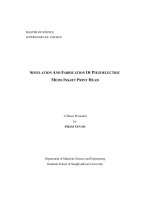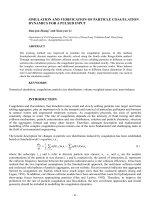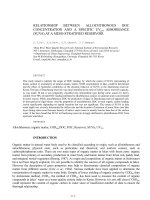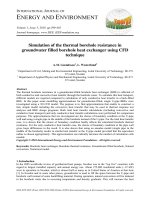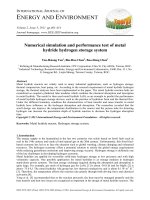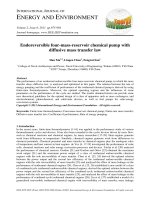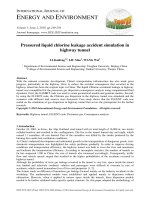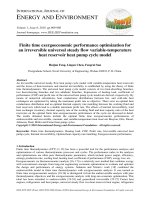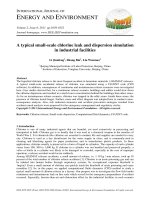Reservoir simulation course
Bạn đang xem bản rút gọn của tài liệu. Xem và tải ngay bản đầy đủ của tài liệu tại đây (12.31 MB, 167 trang )
FUNDAMENTALS OF RESERVOIR
SIMULATION
Dr.
Mai
Cao
Lan,
GEOPET,
HCMUT,
Vietnam
Jan,
2014
ABOUT THE COURSE
COURSE OBJECTIVE
COURSE OUTLINE
REFERENCES
9/11/16
Dr.
Mai
Cao
Lan,
F aculty
of
G eology
&
Petroleum
Engineering,
HCMUT,
Vietnam
2
Course
Objective
•
To review the background of petroleum reservoir
simulation with an intensive focus on what and how
things are done in reservoir simulations
•
To provide guidelines for hands-‐‑on practices with
Microsoft Excel
9/11/16
Dr.
Mai
Cao
Lan,
F aculty
of
G eology
&
Petroleum
Engineering,
HCMUT,
Vietnam
3
COURSE OUTLINE
INTRODUCTION
FLOW EQUATIONS FOR PETROLEUM RESERVOIRS
FINITE DIFFERENCE METHOD &
NUMERICAL SOLUTION FOR
FLOW EQUATIONS
SINGLE-‐‑PHASE FLOW SIMULATION
MULTIPHASE FLOW SIMULATION
References
§
T.
Eterkin et
al.,
2001.
Basic
Applied
Reservoir
Simulation,
SPE,
Texas
§
J.H.
Abou-‐‑Kassem et
al.,
2005.
Petroleum
Reservoir
Simulation
– A
Basic
Approach,
Gulf
Publishing
Company,
Houston,
Texas.
§
C.Mattax &
R.
Dalton,
1990.
Reservoir
Simulation,
SPE,
Texas.
9/11/16
Mai Cao Lân – Faculty of Geology & Petroleum Engineering - HCMUT
5
INTRODUCTION
NUMERICAL SIMULATION – AN OVERVIEW
COMPONENTS OF A
RESERVOIR SIMULATOR
RESERVOIR SIMULATION BASICS
9/11/16
Dr.
Mai
Cao
Lan,
F aculty
of
G eology
&
Petroleum
Engineering,
HCMUT,
Vietnam
6
Numerical
Simulation
– An
Overview
9/11/16
Dr.
Mai
Cao
Lan,
F aculty
of
G eology
&
Petroleum
Engineering,
HCMUT,
Vietnam
7
Mathematical
Formulation
9/11/16
Dr.
Mai
Cao
Lan,
F aculty
of
G eology
&
Petroleum
Engineering,
HCMUT,
Vietnam
8
Numerical
Methods
for
PDEs
9/11/16
Dr.
Mai
Cao
Lan,
F aculty
of
G eology
&
Petroleum
Engineering,
HCMUT,
Vietnam
9
Numerical
Methods
for
Linear
Equations
9/11/16
Dr.
Mai
Cao
Lan,
F aculty
of
G eology
&
Petroleum
Engineering,
HCMUT,
Vietnam
10
Components
of
a
Reservoir
Simulator
Computer
Code
Physical
Model
Reservoir
Simulator
Mathematical
Model
9/11/16
Numerical
Model
Dr.
Mai
Cao
Lan,
F aculty
of
G eology
&
Petroleum
Engineering,
HCMUT,
Vietnam
11
What
is
Reservoir
Simulation?
•
A powerful tool for evaluating reservoir performance
with the purpose of establishing a sound field
development plan
•
A helpful tool for investigating problems associated with
the petroleum recovery process and searching for
appropriate solutions to the problems
9/11/16
Dr.
Mai
Cao
Lan,
F aculty
of
G eology
&
Petroleum
Engineering,
HCMUT,
Vietnam
12
Reservoir
Simulation
Basics
• The
reservoir
is
divided
into
a
number
of
cells
• Basic
data
is
provided
for
each
cell
• Wells
are
positioned
within
the
cells
• The
required
well
production
rates
are
specified
as
a
function
of
time
• The
equations
are
solved
to
give
the
pressure
and
saturations
for
each
block
as
well
as
the
production
of
each
phase
from
each
well.
9/11/16
Dr.
Mai
Cao
Lan,
F aculty
of
G eology
&
Petroleum
Engineering,
HCMUT,
Vietnam
13
Simulating
Flow
in
Reservoirs
• Flow
from
one
grid
block
to
the
next
• Flow
from
a
grid
block
to
the
well
completion
• Flow
within
the
wells
(and
surface
networks)
Flow
=
Transmissibility
*
Mobility
*
Potential
Difference
Geometry
&
Properties
9/11/16
Fluid
Properties
Well
Production
Dr.
Mai
Cao
Lan,
F aculty
of
G eology
&
Petroleum
Engineering,
HCMUT,
Vietnam
14
SINGLE-‐‑PHASE FLOW
EQUATIONS
ESSENTIAL PHYSICS
CONTINUITY EQUATION
MOMENTUM EQUATION
CONSTITUTIVE EQUATION
GENERAL 3D
SINGLE-‐‑PHASE FLOW EQUATION
BOUNDARY &
INITIAL CONDITIONS
9/11/16
Dr.
Mai
Cao
Lan,
F aculty
of
G eology
&
Petroleum
Engineering,
HCMUT,
Vietnam
15
Essential
Physics
The basic differential equations are derived from the
following essential laws:
§
Mass
conservation
law
§
Momentum
conservation
law
§
Material
behavior
principles
9/11/16
Dr.
Mai
Cao
Lan,
F aculty
of
G eology
&
Petroleum
Engineering,
HCMUT,
Vietnam
16
Conservation
of
Mass
Mass
conservation
may
be
formulated
across
a
control
element
with
one
fluid
of
density
ρ, flowing
through
it
at
a
velocity
u:
u
ρ
Δx
⎧Mass into the ⎫ ⎧Mass out of the ⎫ ⎧Rate of change of mass⎫
⎨
⎬ − ⎨
⎬ = ⎨
⎬
element
at
x
element
at
x
+
Dx
inside
the
element
⎩
⎭ ⎩
⎭ ⎩
⎭
9/11/16
Dr.
Mai
Cao
Lan,
F aculty
of
G eology
&
Petroleum
Engineering,
HCMUT,
Vietnam
17
Continuity
Equation
Based
on
the
mass
conservation
law,
the
continuity
equation
can
be
expressed
as
follow:
∂
∂
− ( Aρ u ) = A (φρ )
∂x
∂t
For
constant
cross
section
area,
one
has:
∂
∂
− ( ρ u ) = (φρ )
∂x
∂t
9/11/16
Dr.
Mai
Cao
Lan,
F aculty
of
G eology
&
Petroleum
Engineering,
HCMUT,
Vietnam
18
Conservation
of
Momentum
Conservation of momentum for fluid flow in porous materials
is governed by the semi-‐‑empirical Darcy's equation, which for
one dimensional, horizontal flow is:
k ∂P
u=−
µ ∂x
9/11/16
Dr.
Mai
Cao
Lan,
F aculty
of
G eology
&
Petroleum
Engineering,
HCMUT,
Vietnam
19
Equation
Governing
Material
Behaviors
§ The behaviors of rock and fluid during the production
phase of a reservoir are governed by the constitutive
equations or also known as the equations of state.
§ In general, these equations express the relationships
between rock & fluid properties with respect to the
reservoir pressure.
9/11/16
Dr.
Mai
Cao
Lan,
F aculty
of
G eology
&
Petroleum
Engineering,
HCMUT,
Vietnam
20
Constitutive
Equation
of
Rock
The behavior of reservoir rock corresponding to the
pressure declines can be expressed by the definition of the
formation compaction
⎛ 1 ⎞ ⎛ ∂φ ⎞
c f = ⎜ ⎟ ⎜ ⎟
⎝ φ ⎠ ⎝ ∂P ⎠T
For
isothermal
processes,
the
constitutive
equation
of
rock
becomes
dφ
= φc f
dP
9/11/16
Dr.
Mai
Cao
Lan,
F aculty
of
G eology
&
Petroleum
Engineering,
HCMUT,
Vietnam
21
Constitutive
Equation
of
Fluids
The behavior of reservoir fluids corresponding to the
pressure declines can be expressed by the definition of fluid
compressibility (for liquid)
1 ⎛ ∂V ⎞
cl = − ⎜
⎟ , l = o, w, g
V ⎝ ∂P ⎠T
For natural gas, the well-‐‑known equation of state is used:
PV = nZRT
9/11/16
Dr.
Mai
Cao
Lan,
F aculty
of
G eology
&
Petroleum
Engineering,
HCMUT,
Vietnam
22
Single-‐‑Phase
Fluid
System
Normally, in single-‐‑phase reservoir simulation, we would
deal with one of the following fluids:
Fluid
System
One
Phase
Gas
9/11/16
One
Phase
Water
One
Phase
Oil
Dr.
Mai
Cao
Lan,
F aculty
of
G eology
&
Petroleum
Engineering,
HCMUT,
Vietnam
23
Single-‐‑Phase
Gas
The gas must be single phase in the reservoir, which means
that crossing of the dew point line is not permitted in order
to avoid condensate fall-‐‑out in the pores. Gas behavior is
governed by:
ρ gs constant
ρg =
=
Bg
Bg
9/11/16
Dr.
Mai
Cao
Lan,
F aculty
of
G eology
&
Petroleum
Engineering,
HCMUT,
Vietnam
24
Single-‐‑Phase
Water
One phase water, which strictly speaking means that the
reservoir pressure is higher than the saturation pressure of
the water in case gas is dissolved in it, has a density
described by:
ρws constant
ρw =
=
Bw
Bw
9/11/16
Dr.
Mai
Cao
Lan,
F aculty
of
G eology
&
Petroleum
Engineering,
HCMUT,
Vietnam
25
